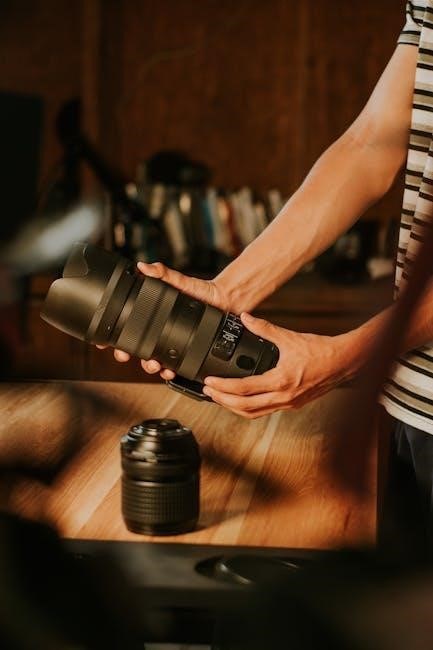programmable controllers pdf
Programmable Logic Controllers (PLCs): An Overview
Programmable Logic Controllers (PLCs) are specialized digital computers used for automation; They control industrial processes, machinery, and systems. PLCs offer flexibility, reliability, and are essential for modern industrial automation, replacing traditional relay-based systems.
What is a PLC?
A Programmable Logic Controller (PLC) is a digital computer designed for controlling industrial automation processes. Unlike general-purpose computers, PLCs are built to withstand harsh environments and are used to automate tasks in factories and industrial plants. They monitor input devices, make decisions based on programmed instructions, and control output devices.
PLCs replaced traditional relay circuits in the 1960s. They are known for their flexibility, allowing modifications to control logic quickly. PLCs perform relay-switching tasks, counting, calculation, and comparison of analog process values. These controllers are compact, and include power supply, processor, memory, and input/output units.
The History and Evolution of PLCs
The Programmable Logic Controller (PLC) emerged in the late 1960s, revolutionizing industrial automation. PLCs evolved from relay-based systems to sophisticated controllers, improving flexibility and control in diverse applications and industries.
The Need for Programmable Controllers
Before PLCs, industrial automation relied on complex relay circuits, which were difficult to modify and troubleshoot. These systems were inflexible, requiring extensive rewiring for even minor changes. The need for programmable controllers arose from the limitations of relay-based systems in terms of space, reliability, and adaptability. Manufacturing processes demanded controllers that could be easily reconfigured to accommodate changing production needs. Early control systems used mechanisms and analog electronics, but they lacked flexibility. Programmable controllers offered a digital solution that could be easily reprogrammed, reducing downtime and improving overall efficiency. The automation industry needed a more versatile and robust control solution.
The Invention and Development of PLCs
The first PLC was invented in the 1960s to replace sequential relay circuits used in machine control. Prior to 1968, programmable controllers did not exist. The invention addressed the need for a more flexible and reliable control system. The development of PLCs involved using solid-state components and programmed instructions. Early PLCs were compact packages with power supplies, processors, memory, and input/output units. Over time, PLCs evolved from simple relay replacements to sophisticated controllers. Modern PLCs use microcontrollers to achieve precise control. These controllers offer flexibility to modify control logic and adapt to changing industrial requirements. The PLC revolutionized the automation industry.
PLC Components and Architecture
PLCs consist of input modules, output modules, and a central processing unit (CPU). The architecture is designed for industrial environments. Input modules receive signals, the CPU processes them, and output modules control devices.
Input Modules
Input modules are crucial components of a PLC system. Their primary function is to receive signals from various field devices, such as sensors, switches, and other input devices. These modules convert the incoming signals into a format that the PLC’s central processing unit (CPU) can understand and process. This conversion often involves changing voltage levels or signal types to match the PLC’s internal operating parameters.
Furthermore, input modules provide isolation between the field devices and the PLC’s internal circuitry, protecting the PLC from voltage spikes or electrical noise. Different types of input modules cater to various signal types, including digital inputs (on/off signals) and analog inputs (variable signals like temperature or pressure). These modules ensure reliable and accurate data acquisition for the PLC.
Output Modules
Output modules serve as the interface between the PLC’s central processing unit (CPU) and the external devices that need to be controlled. These modules receive signals from the PLC’s CPU, typically after the PLC has processed input signals and executed its programmed logic. The output modules then convert these signals into a form suitable for controlling field devices, such as motors, valves, actuators, and lights.
Common types of output modules include relay outputs, transistor outputs, and triac outputs. Each type is suited for different voltage and current requirements of the controlled devices. Output modules also provide isolation to protect the PLC from the voltage and current demands of the external devices. They are essential for translating the PLC’s control decisions into real-world actions.
Processor and Memory
The processor is the brain of the PLC, executing the control program stored in the memory. It retrieves input data, processes it according to the programmed logic, and updates the outputs. The processor’s speed and architecture determine the PLC’s overall performance and its ability to handle complex control tasks.
The memory stores the PLC’s operating system, the user-defined control program, and data related to input and output states. There are different types of memory, including RAM for temporary data storage, ROM for the operating system, and EEPROM or Flash memory for the control program, which retains data even when power is lost. Adequate memory capacity is crucial for accommodating large and complex control programs. Faster processors and larger memory enhance PLC capabilities.
PLC Programming Fundamentals
PLC programming involves creating instructions that define the control logic. Ladder logic is a common language, visually representing relay circuits. Other languages like structured text and function block diagrams are also used.
Ladder Logic Programming
Ladder logic is a primary programming method for PLCs, visually resembling electrical relay circuits. It uses symbols representing contacts, coils, and functions, simplifying the translation of control requirements into code. Programmers construct “rungs” that define logical operations.
Each rung evaluates conditions and activates outputs based on the input states. Ladder logic is intuitive for electricians and technicians familiar with relay-based control systems. It offers a straightforward approach to implementing sequential control, interlocking, and other control functions.
Its graphical nature makes it easier to understand and troubleshoot compared to text-based languages. While other languages exist, ladder logic remains a cornerstone of PLC programming due to its simplicity and wide adoption within the industry for basic control tasks.
Programming Languages for PLCs
While ladder logic is a dominant language, PLCs support diverse programming methods. Instruction List (IL) offers a low-level, assembly-like language for precise control. Structured Text (ST) provides a high-level, Pascal-like environment for complex algorithms. Function Block Diagram (FBD) uses graphical blocks representing functions, simplifying complex systems design.
Sequential Function Chart (SFC) structures programs into steps, ideal for process control. These languages cater to various programming styles and application complexities. IEC 61131-3 standardizes these languages, enhancing portability across PLC brands. The choice depends on the programmer’s expertise and project requirements. Some PLCs also support custom languages, offering greater flexibility for specialized applications. Selecting the right language optimizes development and maintainability.
Applications of PLCs in Industry
PLCs are found extensively in industries automating manufacturing processes, controlling machinery, and managing complex systems. They are vital in applications ranging from factory assembly lines to large-scale process control environments.
Factory Automation
PLCs are integral to modern factory automation, controlling a wide array of processes. They manage assembly lines, robotic systems, and material handling equipment, enhancing efficiency and precision. PLCs also monitor production parameters, ensuring quality control and optimizing resource utilization. Their flexibility allows for easy adaptation to changing production needs, reducing downtime and improving overall productivity.
Furthermore, PLCs enable real-time data collection and analysis, providing valuable insights for process optimization. They integrate seamlessly with other factory systems, such as SCADA and MES, creating a comprehensive automation solution. The use of PLCs in factory automation contributes to increased output, reduced labor costs, and improved product quality, making them essential for competitive manufacturing.
Process Control Systems
PLCs play a crucial role in process control systems, managing complex industrial processes with precision. They monitor and regulate parameters like temperature, pressure, and flow in industries such as chemical, oil and gas, and water treatment. PLCs ensure consistent product quality and efficient resource management by automating control loops and implementing advanced control strategies.
Their ability to handle analog and digital signals makes them versatile for various process control applications. PLCs also provide safety interlocks and alarms, protecting equipment and personnel. The integration of PLCs in process control systems leads to improved process stability, reduced variability, and enhanced safety. Furthermore, they facilitate remote monitoring and control, enabling efficient operation and maintenance of geographically dispersed facilities. They are essential for optimizing process performance.
Advantages of Using PLCs
PLCs offer numerous advantages, including increased flexibility and re-programmability. They enhance control capabilities and troubleshooting efficiency. PLCs are compact, reliable, and improve overall automation system performance, leading to reduced downtime and increased productivity.
Flexibility and Re-programmability
One of the most significant advantages of Programmable Logic Controllers (PLCs) lies in their exceptional flexibility and re-programmability. Unlike traditional relay-based systems that require extensive rewiring for modifications, PLCs can be easily adapted to new tasks by simply altering the software program. This feature significantly reduces downtime and allows for quick adjustments to changing production needs. The ability to re-program PLCs also makes them suitable for a wide range of applications, from simple control tasks to complex automation processes. Furthermore, this flexibility enables continuous improvement and optimization of control strategies, ensuring that the system remains efficient and effective over time. This adaptability is crucial in today’s dynamic industrial environment.
Improved Control and Troubleshooting
PLCs offer vastly improved control capabilities compared to older, traditional systems. Their ability to execute complex algorithms and handle vast amounts of data enables more precise and efficient control processes. Furthermore, PLCs provide comprehensive diagnostic tools and monitoring features. These tools aid in rapid troubleshooting, significantly reducing downtime and maintenance costs. Detailed error logs and real-time status updates allow technicians to quickly identify and resolve issues. The improved control and troubleshooting capabilities of PLCs contribute to increased productivity, reduced operational costs, and enhanced overall system reliability. With their advanced features, PLCs empower operators to maintain optimal performance and minimize disruptions in industrial automation environments. This leads to better efficiency.




